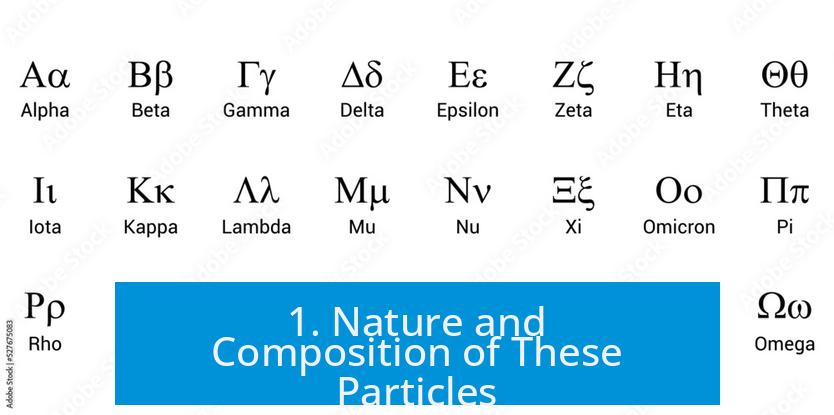What Are Alpha, Beta, and Gamma Particles?

Alpha particles are helium nuclei composed of two protons and two neutrons, carrying a +2 positive charge. Beta particles are electrons or positrons emitted from the nucleus, carrying negative or positive charge respectively. Gamma particles are photons—electromagnetic radiation with no mass or charge.
1. Nature and Composition of These Particles

Alpha Particles
Alpha particles consist of two protons and two neutrons. This structure is identical to the nucleus of a helium atom. They carry a +2 electrical charge, making them positively charged particles. Because of their size and charge, alpha particles interact strongly with matter but cannot penetrate far.
Beta Particles
Beta particles are electrons emitted during radioactive decay. These nuclear electrons carry a negative charge. In some cases, the emitted beta particles are positrons, which are anti-electrons with a positive charge. Beta decay occurs when a neutron transforms into a proton or vice versa in the nucleus, expelling an electron or positron.
Gamma Particles
Gamma particles differ fundamentally from alpha and beta particles. They are photons, a form of electromagnetic radiation like visible light but with much higher energy. Gamma rays have no mass and no electric charge. They are emitted simultaneously with alpha or beta particles to remove excess nuclear energy.
2. Origins and Occurrence
Alpha, beta, and gamma particles arise from radioactive decay processes in unstable atomic nuclei. Certain heavy elements, such as uranium or radium, occur naturally in the Earth’s crust. Their decay releases these particles as the atom moves toward a more stable configuration.
- Alpha decay occurs typically in very heavy nuclei that emit helium nuclei to reduce proton excess.
- Beta decay involves a neutron-to-proton conversion (or reverse), emitting electrons or positrons.
- Gamma emission follows alpha or beta decay, releasing leftover energy in the form of photons.
3. Why Do Atoms Emit Alpha Particles?
Heavy atoms are often unstable due to the large number of protons. The repulsive forces among protons cause instability. Rather than emitting a single proton or neutron, heavy atoms release alpha particles composed of two protons and two neutrons.
This process happens through quantum tunneling, where the alpha particle overcomes a classical energy barrier to escape the nucleus. By shedding an alpha particle, the atom achieves a lower-energy, more stable state.
4. Penetration and Safety Considerations
The ability of each particle to penetrate materials differs significantly:
| Particle | Composition | Charge | Penetration Power | Typical Shielding |
|---|---|---|---|---|
| Alpha | 2 protons + 2 neutrons (helium nucleus) | +2 | Low | Skin, clothing, paper |
| Beta | Electron or positron | -1 (electron), +1 (positron) | Moderate | Plastic, glass, thin metal |
| Gamma | Photon (no mass) | 0 | High | Lead, concrete |
Alpha particles cannot penetrate the outer dead layer of human skin or clothing, making external exposure generally safe. However, if ingested or inhaled, alpha emitters pose high internal damage risk. Beta particles penetrate deeper than alpha but are stopped by walls or protective layers. Gamma rays pass through most materials and require dense shields.
Consider an experiment with three radioactive sources emitting alpha, beta, and gamma particles respectively:
Eat one, sit on one, throw one out the window.
Safe choices:
- Eat the gamma source — gamma rays mostly pass through the body without causing as much damage internally.
- Sit on the alpha source — alpha particles cannot penetrate clothing or skin, so sitting on it shields you.
- Throw the beta source away — beta particles cause damage upon close contact, so it is unsafe to eat or sit on.
5. Historical Context of Naming
Scientists studying early radioactive decay used Greek letters to classify emitted particles for convenience. Key figures such as Rutherford, Becquerel, and Curie contributed to this terminology. Alpha was assigned to the least penetrating and heaviest particles, beta to intermediate particles, and gamma to the highly penetrating, massless radiation.
6. Summary Table of Key Properties
| Particle | Composition | Charge | Penetration | Typical Source |
|---|---|---|---|---|
| Alpha | 2 protons + 2 neutrons (helium nucleus) | +2 | Low (stopped by skin) | Heavy nuclei decay (Uranium, Radium) |
| Beta | Electron or positron | -1 or +1 | Moderate (stopped by walls) | Nuclear neutron/proton conversions |
| Gamma | Photon (electromagnetic radiation) | 0 | High (passes through dense materials) | Nuclear energy release after decay |
7. Practical Origins and Context
Radioactive particles arise naturally in the Earth’s crust, where unstable isotopes decay by emitting alpha, beta, and gamma radiation following a decay chain. These processes gradually transform one element into another while releasing energy.
Understanding these different radiation types helps in nuclear science, radiation safety, medical applications, and environmental monitoring. Each particle’s unique characteristics dictate how radiation is detected, shielded, and applied.
Key Takeaways
- Alpha particles are positively charged helium nuclei with low penetration power.
- Beta particles are electrons or positrons with moderate penetration ability.
- Gamma particles are massless, chargeless photons with high penetrating power.
- Heavy atoms emit alpha particles to reduce instability via quantum tunneling.
- Alpha particles are stopped by skin; beta require thicker layers; gamma rays need dense shielding.
- The terms alpha, beta, and gamma originate from early studies of radioactivity using Greek letters.
- Natural radioactive decay in Earth’s crust releases these particles continuously.
What exactly are alpha particles made of?
Alpha particles consist of two protons and two neutrons. They are essentially helium nuclei and carry a positive charge of +2.
How do beta particles differ from alpha particles?
Beta particles are electrons emitted from a nucleus and carry a negative charge. Unlike alpha particles, beta particles have moderate penetration and can pass through some materials but not thick walls.
What are gamma particles and why are they different from alpha and beta?
Gamma particles are photons, meaning they have no mass or charge. They are a form of electromagnetic radiation that penetrate deeply and cannot be stopped easily.
Why are alpha particles stopped by skin but gamma particles are not?
Alpha particles have low penetration power and are blocked by skin or clothing. Gamma rays are highly penetrating photons that pass through the body and most materials.
Why do heavy atoms emit alpha particles?
Heavy atoms are unstable due to too many protons. Quantum tunneling allows them to eject alpha particles, which helps the atom become more stable.





Leave a Comment